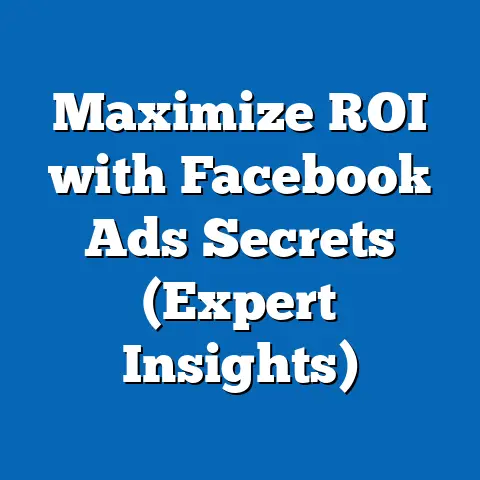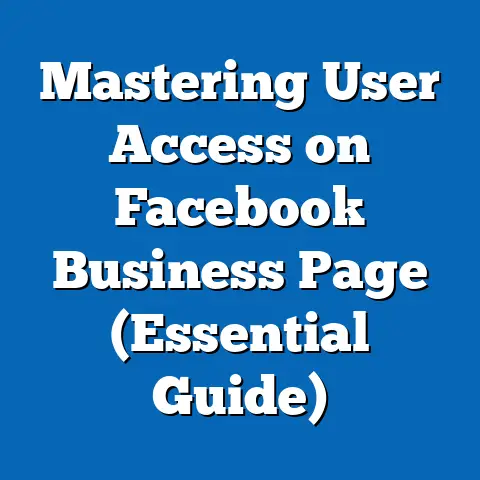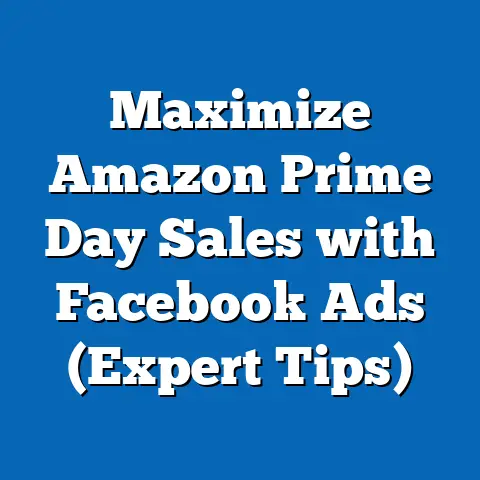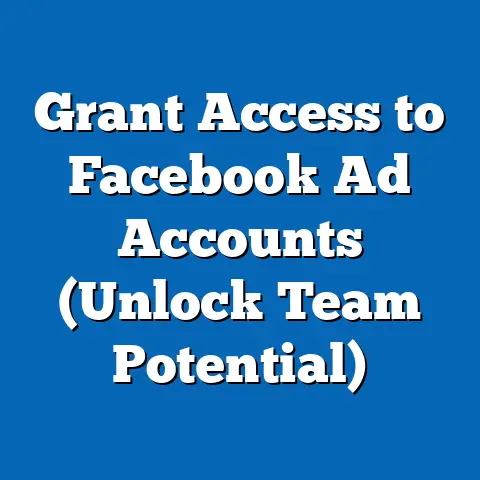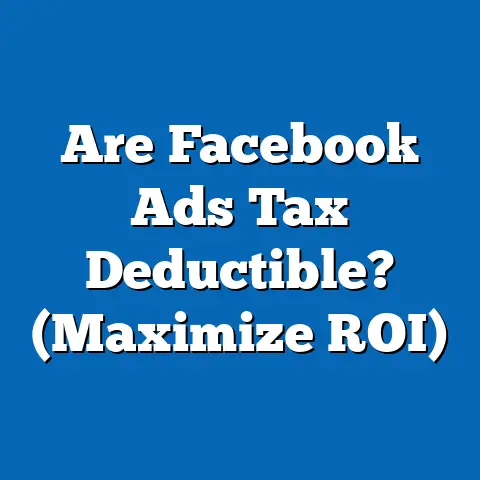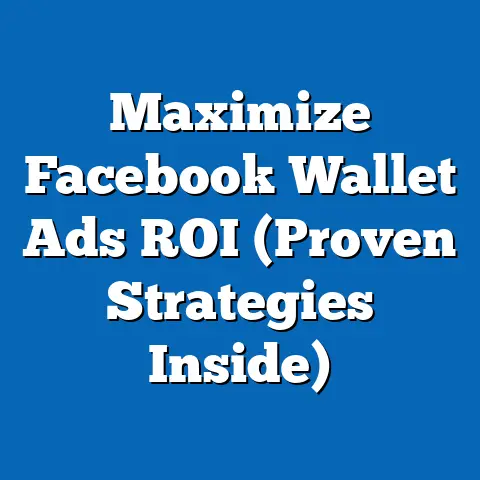Unlock Effective Targeting: Do Facebook Ads Still Work? (Insightful Analysis)
I’ve seen Facebook ads evolve from simple sidebar banners to the sophisticated, data-driven campaigns we see today. I’ve also witnessed the rise of skepticism, with many marketers wondering if Facebook ads still pack the punch they used to. It’s a valid question. On one hand, Facebook boasts billions of active users, making it a potential goldmine for reaching your target audience. On the other hand, algorithm changes, privacy concerns, and increased competition have made it harder to cut through the noise.
Section 1: The Evolution of Facebook Ads
To truly understand where Facebook ads stand today, it’s crucial to look back at their journey. I remember the early days when Facebook ads were almost an afterthought, a small section on the side of the page. They were basic, with limited targeting options and rudimentary creative capabilities. But even then, the potential was evident.
From Humble Beginnings to a Marketing Powerhouse
Facebook ads officially launched in 2007, offering businesses the ability to target users based on basic demographics like age, location, and interests. This was a game-changer compared to traditional advertising, which often relied on broad demographics. For the first time, businesses could directly reach specific groups of people with tailored messages.
Over the years, Facebook steadily added more sophisticated targeting options, ad formats, and features. Some key milestones include:
- 2009: The introduction of “Like” buttons and social ads, allowing businesses to leverage social proof and word-of-mouth marketing.
- 2012: The acquisition of Instagram, opening up a new avenue for advertisers to reach a younger, visually-oriented audience.
- 2013: The launch of Custom Audiences, enabling businesses to target users based on their own customer data, such as email lists and website visitors. This was a major step towards personalized advertising.
- 2015: The introduction of the Facebook Pixel, a tracking code that allows businesses to measure the effectiveness of their ads and retarget website visitors.
- 2016: The rise of video ads, capitalizing on the increasing popularity of video content on social media.
- 2018: Increased focus on transparency and privacy, with stricter ad policies and the implementation of GDPR.
How Algorithm Changes Impacted Advertisers
Throughout this evolution, Facebook’s algorithm has been a constant force shaping the effectiveness of ads. In the early days, organic reach was relatively high, meaning businesses could reach a significant portion of their followers without paying for ads. However, as Facebook’s user base grew and the platform became more crowded, the algorithm began prioritizing content from friends and family over content from businesses. This led to a sharp decline in organic reach, forcing businesses to rely more heavily on paid advertising to reach their target audience.
I’ve personally seen this shift firsthand. What used to work organically suddenly required a paid boost to get even a fraction of the same visibility. This change forced marketers to become more strategic and data-driven in their approach to Facebook advertising. We had to learn how to optimize our ads for relevance, engagement, and conversions to get the best possible ROI.
Furthermore, algorithm updates like the one in early 2018, which prioritized “meaningful interactions,” further emphasized the importance of creating engaging content that resonates with users on a personal level. Generic, sales-focused ads became less effective, while ads that told a story, sparked conversations, or provided value gained more traction.
Takeaway: Understanding the evolution of Facebook ads and the impact of algorithm changes is essential for developing effective advertising strategies. By adapting to the platform’s ever-changing landscape, you can maximize your chances of success.
Section 2: Understanding the Mechanics of Facebook Ads
Before diving into the effectiveness of Facebook ads, it’s crucial to understand the underlying mechanics of the platform. Think of it as understanding the engine before you start driving a car. Knowing the key components and how they work together will empower you to create more targeted and effective campaigns.
Audience Targeting Options: Reaching the Right People
One of the most powerful aspects of Facebook advertising is its sophisticated audience targeting capabilities. I’ve been consistently impressed by the level of granularity it offers. You can target users based on a wide range of factors, including:
- Demographics: Age, gender, location, education, relationship status, and more.
- Interests: Hobbies, passions, and topics they engage with on Facebook.
- Behaviors: Purchase history, online activity, device usage, travel habits, and more.
- Connections: People who like your page, their friends, or people who have interacted with your ads.
- Custom Audiences: As mentioned earlier, you can upload your own customer data, such as email lists or phone numbers, to target specific individuals.
- Lookalike Audiences: Facebook can identify users who share similar characteristics with your existing customers, allowing you to expand your reach to new, relevant audiences.
I remember working with a client who sold organic baby food. By combining demographic targeting (parents with young children) with interest-based targeting (users interested in organic food, parenting blogs, and baby products), we were able to reach a highly targeted audience and achieve a significantly higher conversion rate compared to traditional advertising methods.
Ad Formats: Choosing the Right Canvas
Facebook offers a variety of ad formats to suit different marketing goals and creative visions. Some of the most popular ad formats include:
- Image Ads: Simple and versatile, ideal for showcasing products or services with visually appealing imagery.
- Video Ads: Engaging and dynamic, perfect for telling stories, demonstrating product features, or capturing attention in a crowded news feed.
- Carousel Ads: Allow you to display multiple images or videos in a single ad unit, ideal for showcasing a range of products or highlighting different aspects of a single product.
- Collection Ads: Designed for e-commerce businesses, these ads feature a main image or video along with a selection of related products.
- Instant Experience Ads: Full-screen, mobile-optimized ads that provide an immersive and interactive experience for users.
- Lead Ads: Designed to capture leads directly on Facebook, these ads feature a form that users can fill out without leaving the platform.
- Stories Ads: Short, vertical videos or images that appear in Facebook and Instagram Stories, ideal for reaching a younger audience with engaging, ephemeral content.
The key is to choose the ad format that best aligns with your marketing goals and target audience. For example, if you’re trying to generate leads, a Lead Ad might be the most effective option. If you’re trying to drive sales for an e-commerce business, a Collection Ad or Carousel Ad could be a better choice.
The Bidding Process and Budget Allocation: Maximizing Your ROI
Facebook ads operate on a bidding system, where advertisers compete for ad placements based on their target audience and budget. You can choose from different bidding strategies, such as:
- Cost Per Click (CPC): You pay each time someone clicks on your ad.
- Cost Per Impression (CPM): You pay for every 1,000 times your ad is shown.
- Cost Per Action (CPA): You pay when someone takes a specific action, such as making a purchase or filling out a form.
Choosing the right bidding strategy depends on your marketing goals and budget. If you’re focused on driving traffic to your website, CPC might be the best option. If you’re focused on brand awareness, CPM could be more effective.
Budget allocation is also crucial for maximizing your ROI. You need to determine how much to spend on each ad campaign and how to distribute your budget across different ad sets and targeting options. I generally recommend starting with a smaller budget and gradually increasing it as you optimize your campaigns and identify what works best.
Takeaway: Understanding the mechanics of Facebook ads, including audience targeting, ad formats, and the bidding process, is essential for creating effective campaigns that deliver results. By mastering these elements, you can reach the right people, capture their attention, and drive conversions.
Section 3: Data-Driven Insights on Facebook Ads Effectiveness
While anecdotal evidence and personal experiences can be valuable, it’s crucial to rely on data-driven insights to assess the true effectiveness of Facebook ads. Let’s dive into some recent statistics and case studies to paint a clearer picture.
Key Statistics on Facebook Ad Performance
- Reach: Facebook still boasts a massive global audience of over 2.9 billion monthly active users, making it one of the largest advertising platforms in the world. This sheer reach provides businesses with unparalleled opportunities to connect with potential customers.
- Engagement: According to Statista, the average engagement rate for Facebook ads across all industries is around 0.9%. While this may seem low, it’s important to consider the sheer volume of content competing for users’ attention on the platform.
- Conversion: The average conversion rate for Facebook ads varies depending on the industry and ad format, but it typically ranges from 2% to 5%. This means that for every 100 people who click on your ad, you can expect 2 to 5 of them to take a desired action, such as making a purchase or filling out a form.
- ROI: Studies have shown that businesses can achieve a significant ROI from Facebook ads, with some reporting returns of $5 or more for every $1 spent. However, ROI varies widely depending on factors such as industry, targeting, ad creative, and campaign optimization.
Case Studies: Real-World Examples of Success
Numerous businesses have achieved remarkable results with Facebook ads. Here are a few examples:
- MVMT Watches: This e-commerce brand used Facebook ads to build brand awareness and drive sales, achieving a 3x return on ad spend and growing their revenue by 300% in just one year.
- Dollar Shave Club: This subscription-based company used Facebook ads to acquire new customers, achieving a cost per acquisition (CPA) that was significantly lower than traditional advertising channels.
- Frank Body: This skincare brand used Facebook ads to target millennials with visually appealing content, achieving a 4x return on ad spend and building a loyal customer base.
These case studies demonstrate that Facebook ads can be highly effective when used strategically and optimized for results.
Comparing Facebook Ads to Other Digital Advertising Platforms
While Facebook ads can be powerful, it’s important to consider how they compare to other digital advertising platforms, such as Google Ads, LinkedIn Ads, and Twitter Ads. Each platform has its own strengths and weaknesses, and the best choice for your business will depend on your specific goals and target audience.
- Google Ads: Ideal for reaching users who are actively searching for specific products or services. It offers granular targeting options based on keywords, location, and device.
- LinkedIn Ads: Best for reaching professionals and businesses. It offers targeting options based on job title, industry, company size, and skills.
- Twitter Ads: Useful for reaching users who are interested in news, trends, and real-time conversations. It offers targeting options based on interests, keywords, and hashtags.
I often advise clients to diversify their advertising efforts across multiple platforms to maximize their reach and minimize their reliance on any single channel.
Takeaway: Data-driven insights and real-world case studies demonstrate that Facebook ads can still be highly effective for reaching target audiences, driving engagement, and generating conversions. However, it’s crucial to track your results, optimize your campaigns, and compare Facebook ads to other digital advertising platforms to determine the best strategy for your business.
Section 4: The Role of Targeting in Advertising Success
In my experience, targeting is the single most important factor in determining the success of a Facebook ad campaign. You can have the most compelling ad creative in the world, but if you’re showing it to the wrong people, it’s unlikely to generate any meaningful results.
Why Audience Targeting Matters
Effective audience targeting allows you to:
- Reach the right people: By targeting users who are most likely to be interested in your products or services, you can increase the relevance of your ads and improve your conversion rates.
- Reduce wasted ad spend: By focusing your budget on the most promising audiences, you can avoid wasting money on users who are unlikely to convert.
- Improve your ROI: By reaching the right people and reducing wasted ad spend, you can significantly improve your return on investment.
Mastering Lookalike Audiences and Retargeting Strategies
Two of the most powerful targeting strategies on Facebook are lookalike audiences and retargeting.
- Lookalike Audiences: As mentioned earlier, lookalike audiences allow you to expand your reach to new users who share similar characteristics with your existing customers. This is a great way to find potential customers who might not have otherwise discovered your business. To create a lookalike audience, you need to provide Facebook with a source audience, such as your customer list, website visitors, or page fans. Facebook will then analyze the characteristics of this audience and identify users who share similar traits.
- Retargeting: Retargeting allows you to show ads to users who have previously interacted with your business, such as visiting your website, adding items to their cart, or watching your videos. This is a highly effective way to re-engage potential customers who have shown interest in your products or services. I’ve seen retargeting campaigns consistently outperform other types of campaigns in terms of conversion rates and ROI.
I once worked with a client who was struggling to generate sales for their online store. By implementing a retargeting campaign that showed ads to users who had abandoned their carts, we were able to recover a significant portion of those lost sales and increase their overall revenue by 20%.
Expert Insights: Tips from Successful Marketers
Here are some tips from successful marketers on how to master Facebook targeting:
- Know your audience: Before you start creating ad campaigns, take the time to research your target audience and understand their demographics, interests, and behaviors.
- Use multiple targeting options: Don’t rely on just one targeting option. Combine multiple options to create a more refined and targeted audience.
- Test different targeting options: Experiment with different targeting options to see what works best for your business.
- Monitor your results: Track your results closely and make adjustments to your targeting based on the data.
- Stay up-to-date: Facebook is constantly adding new targeting options, so stay informed about the latest features and best practices.
Takeaway: Audience targeting is the cornerstone of successful Facebook advertising. By mastering lookalike audiences, retargeting strategies, and other advanced targeting techniques, you can reach the right people, improve your ROI, and achieve your marketing goals.
Section 5: Challenges and Criticisms of Facebook Ads
While Facebook ads offer tremendous potential, they’re not without their challenges and criticisms. It’s important to acknowledge these issues and understand how they can impact your advertising effectiveness.
Ad Fatigue and Declining Organic Reach
One of the biggest challenges facing Facebook advertisers is ad fatigue. As users see the same ads repeatedly, they become less likely to engage with them. This can lead to a decline in ad performance and a decrease in ROI.
I’ve found that combating ad fatigue requires constantly refreshing your ad creative and targeting options. Try creating new ad variations, testing different headlines and images, and experimenting with new targeting strategies.
As I mentioned earlier, declining organic reach is another major challenge. As Facebook prioritizes content from friends and family, it’s become increasingly difficult for businesses to reach their followers without paying for ads. This has forced businesses to rely more heavily on paid advertising, which can increase their marketing costs.
Privacy Concerns and the Impact of Data Regulations
In recent years, privacy concerns have become a major issue for Facebook and its advertisers. The Cambridge Analytica scandal and other data breaches have raised awareness about the way Facebook collects and uses user data. This has led to increased scrutiny from regulators and stricter data privacy regulations, such as GDPR (General Data Protection Regulation) in Europe.
These regulations have impacted Facebook advertisers in several ways:
- Reduced targeting options: GDPR has limited the types of data that advertisers can use for targeting, making it more difficult to reach specific audiences.
- Increased transparency: Facebook has become more transparent about the way it uses user data, giving users more control over their privacy settings.
- Increased compliance costs: Businesses must now comply with GDPR and other data privacy regulations, which can increase their legal and administrative costs.
Increased Competition and Rising Costs of Advertising
As more businesses flock to Facebook advertising, competition for ad placements has increased, driving up the cost of advertising. This can make it more difficult for small businesses and startups to compete with larger companies that have deeper pockets.
I’ve seen CPC and CPM rates steadily increase over the years, especially during peak advertising seasons like the holidays. To combat rising costs, it’s essential to optimize your ads for relevance and engagement. Create high-quality ad creative, target your audience effectively, and experiment with different bidding strategies to find the most cost-effective approach.
Takeaway: Facebook ads face several challenges and criticisms, including ad fatigue, declining organic reach, privacy concerns, and increased competition. By understanding these issues and implementing strategies to mitigate their impact, you can improve your advertising effectiveness and achieve your marketing goals.
Section 6: Future Trends in Facebook Advertising
The world of Facebook advertising is constantly evolving, with new trends and technologies emerging all the time. It’s crucial to stay informed about these trends to adapt your strategies and stay ahead of the curve.
The Integration of Artificial Intelligence (AI)
AI is already playing a significant role in Facebook advertising, and its influence is only going to grow in the future. Facebook is using AI to:
- Improve ad targeting: AI algorithms can analyze vast amounts of user data to identify the most relevant audiences for your ads.
- Optimize ad creative: AI can help you create more engaging ad creative by automatically generating headlines, images, and videos.
- Automate bidding: AI-powered bidding strategies can automatically adjust your bids to maximize your ROI.
I believe that AI will continue to revolutionize Facebook advertising in the years to come, making it more efficient, effective, and personalized.
Augmented Reality (AR) Ads
Augmented reality (AR) ads are still in their early stages, but they have the potential to transform the way businesses engage with customers on Facebook. AR ads allow users to interact with products and services in a virtual environment, creating a more immersive and engaging experience.
For example, a furniture retailer could use AR ads to allow users to see how a piece of furniture would look in their home before making a purchase. A cosmetics brand could use AR ads to allow users to try on different makeup products virtually.
I’m excited to see how AR ads evolve in the future and how businesses will use them to create innovative and engaging advertising experiences.
The Rise of Influencer Marketing on Facebook
Influencer marketing has become increasingly popular on social media, and Facebook is no exception. Businesses are partnering with influencers to reach their target audiences and build brand awareness.
Facebook offers a variety of tools and features to help businesses connect with influencers and manage their influencer marketing campaigns. For example, Facebook Brand Collabs Manager allows businesses to find and connect with influencers who are relevant to their brand.
I believe that influencer marketing will continue to be a key trend in Facebook advertising in the future, as businesses seek to leverage the credibility and reach of influencers to connect with potential customers.
Takeaway: The future of Facebook advertising is likely to be shaped by AI, AR, and influencer marketing. By embracing these emerging trends, you can stay ahead of the curve and create more engaging and effective advertising campaigns.
Section 7: Conclusion
So, do Facebook ads still work? The answer, as with most things in marketing, is nuanced. We’ve seen how Facebook ads have evolved, from simple banners to sophisticated, data-driven campaigns. We’ve explored the mechanics of the platform, analyzed data-driven insights, and discussed the importance of targeting. We’ve also acknowledged the challenges and criticisms of Facebook ads, such as ad fatigue, privacy concerns, and rising costs.
The truth is, Facebook ads are not a magic bullet. They require careful planning, strategic targeting, compelling creative, and ongoing optimization. But when used effectively, they can still be a powerful tool for reaching your target audience, driving engagement, and generating conversions.
I’ve personally witnessed the transformative power of Facebook ads for countless businesses, from small startups to large corporations. But I’ve also seen campaigns fail miserably due to poor targeting, uninspired creative, or a lack of understanding of the platform.
Ultimately, the effectiveness of Facebook ads depends on you. It depends on your ability to understand your audience, craft compelling messages, and adapt to the ever-changing landscape of the platform.
So, as you reflect on your own experiences with Facebook advertising and its future potential, ask yourself: Are you willing to invest the time, effort, and resources necessary to make Facebook ads work for you? The answer to that question will determine whether Facebook ads are still a viable option for your business.

